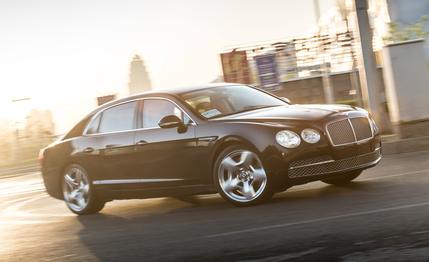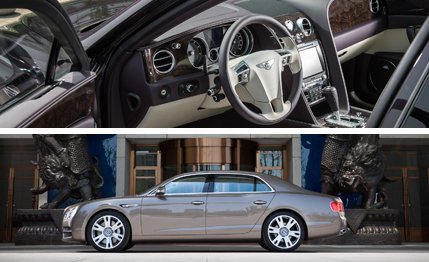 First Drive Review
First Drive Review
Like the members of your local Lions Club in their private moments, the auto industry is obsessed with stiffness. It seems that every model redesign brings boasts of increased torsional rigidity, augmented bending stiffness, and firmer suspensions. Not this time. Bentley claims the 2014 Flying Spur’s front and rear air springs are 10 and 13 percent softer, respectively, than its predecessor’s. It goes on to say the new model’s front and rear anti-roll bars are 13 and 15 percent less starchy. And bushings throughout the suspension are described as anywhere from 25 to 38 percent more flocculent than the outgoing car’s. (Rest assured, Rotary Club members, the body shell’s torsional rigidity is said to improve by four percent.)
The marketers in Crewe did this in pursuit of a more luxurious ride—and, probably, in pursuit of greater acceptance in emerging markets with occasionally lumpy roads such as China, where we drove the new Flying Spur. To distance its refocused sedan from the coupe with which it shares its underpinnings, Bentley is dropping “Continental” from the four-door’s moniker. Name dropping might be a regular activity for people who know Bentley owners—and want you to know it—but this marks the first time the company has gotten in on the game.
More Power, Torque, and Gears
Other aspects of this redesign follow a more familiar script. The 6.0-liter W-12 sees increased output, from 552 horsepower to 616 and 479 lb-ft of torque to 590, the new figures being the same as those of the uplevel Continental GT Speed. Rather than last year’s six-speed automatic, the 12-holer now spins cogs in ZF’s eight-ratio autobox. Pleased with the effect of the slight rearward bias in the all-wheel-drive system of its extreme Continental GT Supersports, Bentley has applied that model’s nominal 40/60 front-to-rear torque split to the Flying Spur as well. When necessary, the car can punt 65 percent forward or 85 percent aft.

The Spur’s new sheetmetal takes cues from Bentley’s flagship Mulsanne. In photos, it’s difficult to appreciate how different the new car’s shape is from the old. The razor-sharp shoulder-line crease and reworked rear quarters and greenhouse not only replicate its big brother’s styling but also have a much more dramatic impact in person than in pictures. If one must have fender vents (and they’re standard, so you must), the stylized “Flying B” emblems in them are a nice touch. The overall width is unchanged, but the front track is 0.8 inch wider, and the rear grows by 1.4 inches.
When Spurs Fly
Bentley says the new Flying Spur is only 110 pounds lighter than its predecessor, but with an extra 100 lb-ft coursing through its Pirelli P Zeros, the new car is said to need just 4.3 seconds to get from stopped to 60 mph. We matched that time in a previous-gen Speed model, so we think we might be able to beat it. Bentley quotes an even 200 mph as the top speed. That’s the same as its claim for last year’s Speed model, and we don’t expect to beat it. With 275 mm of powered P Zero at each corner, the Bentley’s catapult impression is flawless, and keeping the accelerator pinned for more than a few seconds at a time guarantees autobahn-worthy speeds.
A new exhaust system and full-length acoustical shielding make the car 40 percent quieter than its predecessor, but we prefer to hear as much of the 12-cylinder engine as possible. Although the cabin is muted most of the time, the engine gets a bit rowdy under full throttle, and not in the most pleasing way. The resonance makes its way into the cabin from the W’s four cylinder banks, and a wild intake whoosh had us wishing the Spur’s new mufflers would let a little more exhaust noise out to better balance the soundtrack. Throttle tip-in is slow, but putting the shifter into Sport or Manual mode changes the mapping for a more aggressive and predictable takeoff. Bentley’s steering-column-mounted shift paddles remain, and although we like their placement and long reach, their bare black-plastic finish seems cheap.